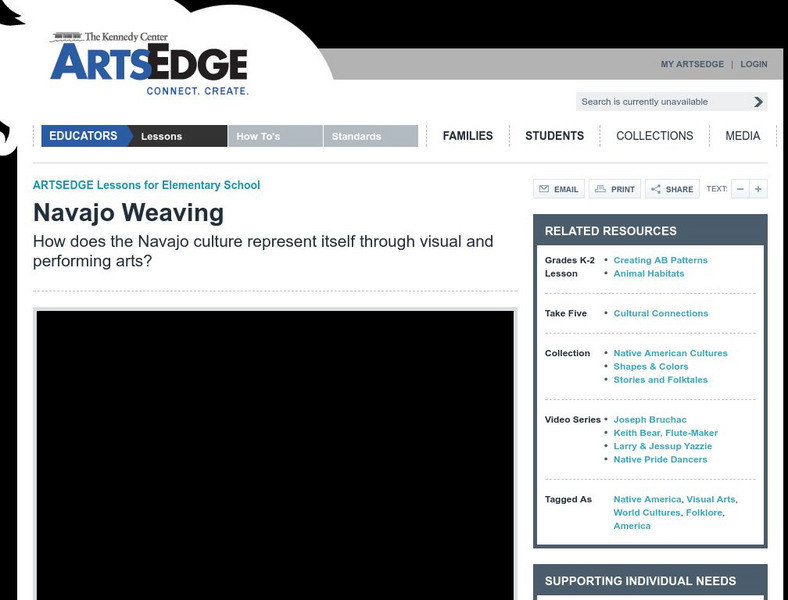University of Iowa
University of Iowa: Art and Life in Africa
A comprehensive resource about African art and cultures.
Other
Art With Mrs. Filmore: 1st Grade Art Lessons
This site offers a variety of art lessons that use various media. Each project includes instructions and pictures of the students' completed artwork.
Other
Humbolt State University: Navaho (Navajo) Weaving
The history and style of Navaho weaving (blankets and rugs) is discussed in this richly illustrated, scholarly essay. With information about characteristic patterns used, color emphasis, and other aesthetic qualities.
Other
Multicultural Literature for Children: Abuela's Weave
This lesson plan is perfect in an ESL classroom. "Abuela's Weave" is the story of a young girl from Guatemala and the beautiful tapestry she creates. Includes prereading questions, vocabulary, and activities to integrate into other...
John F. Kennedy Center
The Kennedy Center: Arts Edge: Navajo Weaving
After studying Navajo weaving and listening to the story "Ten Little Rabbits," students create their own interpretive dances. Contains an assessment checklist and extensions ideas.
Smithsonian Institution
Smithsonian American Art Museum: Lia Cook: Textile Painter
The artwork of Lia Cook, textile painter is profiled. Cook has a unique way of "weaving paintings" by dying silk cords, painting linen threads, and weaving them together to create figures and motifs.
Other
Alien Travel Guide: History of Weaving
This site from the Alien Travel Guide contains an outline to information on the history of weaving. The outline is in link form for easy navigation and it contains wonderful basic information.
Marilyn J. Brackney
Imagination Factory: Soda Straw Weaving
Using plastic straws and yarn, young children can weave a bracelet or bookmark. Website includes detailed instruction on how to weave using soda straws and images showing the various steps.
Other
Artisans in Focus: The Art of Weaving
This site from Artisans in Focus contains wonderful information on the art of weaving. The site is outlined in link form for easy navigation and it contains information on subjects such as: preparing the yarn, dying the yarn, natural...
Other
Tapestry Art Design: A History of Tapestries
Discover the medieval beginnings of tapestry weaving through the present day.
Smithsonian Institution
Smithsonian American Art Museum: Lia Cook
As part of the Smithsonian Art Museum's database of artists, Lia Cook is described here along with information on his contributions to art through her work with weaving, textiles, and draped fabric.
Other
Mayan Culture: Maya Weavers
Explore the world of Mayan weaving with this colorful site! Provides photos of this ancient art, as well as links to more information on symbols, weaving techniques, materials, and more.
Smithsonian Institution
Smithsonian American Art Museum: Lenore Tawney
As part of the Smithsonian Art Museum's database of artists, Lenore Tawney is described here along with information on her contributions to art through her weavings and weaving techniques (she switched over to weaving from sculpture).
Smithsonian Institution
The Fabric of Moroccan Life Rural Weavings
Berber peoples, the indigenous inhabitants of rural Morocco, are known for their spectacular weaving. Shown on this website are 14 different examples.
Smithsonian Institution
Smithsonian Education: Art to Zoo Spinning Yarns, Telling Tales About Textiles
A great resource for introducing different types of textiles and weavings to your learners. A good amount of background information is included as well as a few simple learning activities.
Metropolitan Museum of Art
Metropolitan Museum of Art: The Unicorn Tapestries
The mythical beast, the unicorn, was depicted in tapestries of the 15th century. This website explores the unicorn tapestries in the collection of The Metropolitan Museum of Art through detailed images. A fun way to explore medieval art.
Smithsonian Institution
Smithsonian American Art Museum: Adela Akers
As part of the Smithsonian Art Museum's database of artists, this site provides biographical information on Adela Akers. Akers worked as a weaver and the site, in addition to the biographical information, makes reference to her famous...
Museum of Fine Arts, Boston
Museum of Fine Arts, Boston: Native North American Art
The MFA's collection of Native American art traces its origins to the 1870s, when the Museum opened to the public. Includes Navajo weavings, Zuni Pueblo pottery, and Plains beadwork. Click on 'View All Works' to access the collection.
Smithsonian Institution
National Museum of African Art: Grass Roots: African Origins of an American Art
Explore the crafts that the African American culture exported from native African lands, basketry and cultivation of rice. With the lessons provided in the downloadable document, students will weave together history, geography, social...
ClassFlow
Class Flow: Art Weaving
[Free Registration/Login Required] This flipchart is a quiz on the craft and techniques of weaving.
TED Talks
Ted: Ted Ed: Weaving Narratives in Museum Galleries
As the director of the Metropolitan Museum of Art in New York, Thomas P. Campbell thinks deeply about curating- not just selecting art objects, but placing them in a setting where the public can learn their stories. With glorious images,...
Other
Card Weaving
This site shows how to weave a strap from the making of the cards to how to use them for weaving.
Texas Instruments
Texas Instruments: Weaving a Story
In this activity, students construct a paper weaving using a chart model. They will also learn skip counting with the TI-10 and recognize number patterns in art.
Other
Peruvian and Bolivian Weavings
Read about the weavers of the South American Andes and their process of weaving.
















